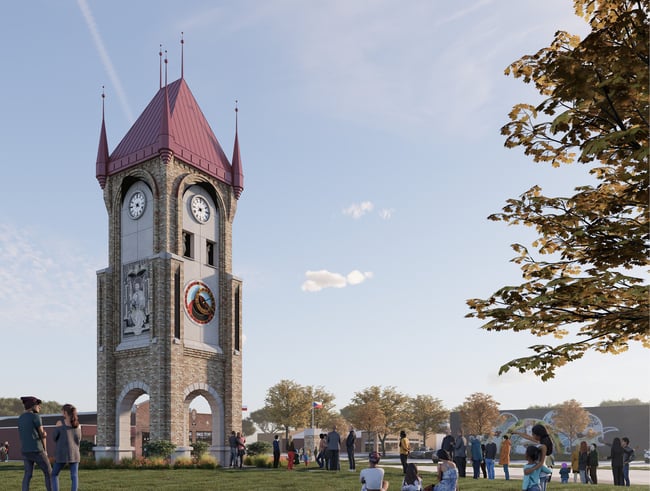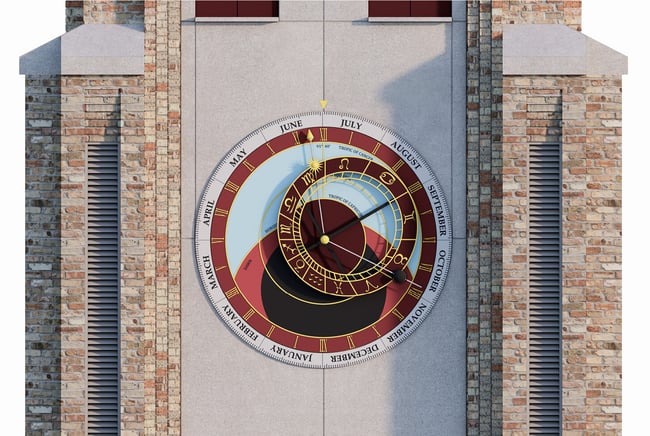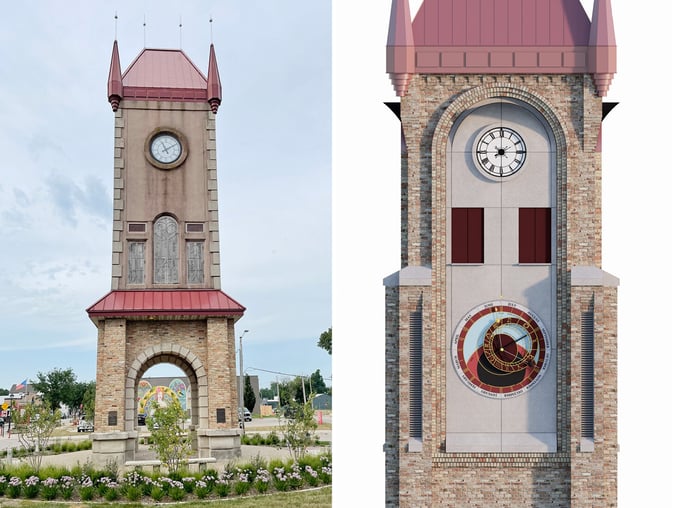Construction to Start on the NCSML Clock Tower Renovation

On May 3, the National Czech & Slovak Museum & Library (NCSML) in Cedar Rapids will host a groundbreaking ceremony to kick off its clock tower renovation. The project will enhance the structure by adding an astronomical clock—the first in the US and one of only three in the world.
While inspired by the famous Prague Orloj, the clock tower’s design will reflect the Cedar Rapids community and its immigration history. At Neumann Monson, we are proud to be part of this project and excited to see its impact on the Czech Village and New Bohemia neighborhoods.
To celebrate the project’s groundbreaking, this article will discuss the project’s background, design process, and the features visitors will experience.
Creating a Local Landmark: Project Background
The NCSML began in 1974 when a group of second and third-generation Czech Americans founded the Czech Fine Arts Foundation to preserve their heritage and culture. Over the years, its collection grew and began including artifacts from Slovak Americans, leading to its current name.
In 1995, NCSML opened a new facility, with US President Bill Clinton, Czech President Václav Havel, and Slovakian President Michal Kováč presiding over the ceremony. The 2008 flood left significant damage, and the facility was later moved and expanded.
The clock tower, part of the original facility, has since fallen into disrepair. Its four clocks are no longer functioning, and the structure suffered damage during the 2020 derecho.
For NCSML, repairing the clock tower was an opportunity to further its mission. In the coming years, the museum hopes to expand its educational offerings, and the project offered a chance to create a local landmark and attract visitors to the Czech Village.

The renovated clock tower is set to be a major attraction to the Czech Village.
The inspiration behind the renovation was the famed Orloj attached to the Old Town Hall in Prague. Dating to the 15th century, this astronomical clock tells the position of the sun, moon, and zodiac constellations in addition to 24-hour time. Before approaching Neumann Monson, NCSML began working with the SPEL Company in Prague, the current caretakers of the Orloj, to design the clock’s inner workings.
Celebrating Local History: Design Features
The design process began by engaging stakeholders to understand the reason and context behind the clock tower renovation. In addition to creating a local landmark, the team saw an opportunity to tell a larger story about the Czech Village and US immigration.
Clock Tower Details
The primary feature—the astronomical clock—will be on the tower’s north side, facing the museum. This location not only opens toward a public gathering space but is also the most ideal location to experience the sun and moon’s position relative to the clock.

The astronomical clock will be the first of its kind in the US.
The east and west sides will contain low-profile relief sculptures representing the Czech Village and New Bohemia (New Bo). These historic neighborhoods, separated by the Cedar River, have a rich, shared immigration history. While immigrants first settled on the east side in New Bo, they gradually moved west across the river to escape factory pollution, establishing the Czech Village.
Above the astrological clock, 12 rotating figurines will appear every half hour. This detail is also inspired by the Prague Orloj, which contains figurines based on the 12 apostles.
The figurines will tell the story of 19th and early 20th-century immigration, with a farmer, a coal miner, a meatpacker, and other sculptures representing those who came from Czech, Slovak, Moravian, and other lands. Each figure will be nearly four feet tall and sculpted from oak by Andrej Harsany of Bratislava, Slovakia.
Façade Redesign
Unlike other building projects, performance was not an issue for the clock tower. Instead, the design focused on the proportions, aesthetics, and how every element would relate.
One of the major decisions was to simplify the façade and its material palette. Currently, the tower includes brick and cast stone at the base and EIFS (Exterior Insulation Finishing System) at the top. Skirting separates the two materials, breaking up the proportions and making the tower look shorter.
The renovation will resolve this issue by continuing the brick to the roof. All new bricks will be salvaged from older buildings to reduce waste and give the tower a more textured appearance.

The renovation will remove the skirting and carry the brick to the roof.
Cast stone will infill the tower faces, creating consistency throughout the structure. When detailing the brickwork around the stone infills, the design team studied architecture in the Czech Village to help the structure harmonize with its surroundings.
Explore Other Building Projects in Iowa
When complete, NCSML’s clock tower will be a beacon in the Cedar Rapids area, attracting more visitors to the city’s historic and cultural district. The destination will further the museum’s mission of promoting culture, freedom, democracy, and immigration.
The project has been a global affair since its start, with input from Czech clockmakers and a Slovak artist. While Graham Construction will oversee the renovation, the clock’s inner workings will be shipped from Europe and installed by a Czech team. Like NCSML’s opening in 1995, the clock tower’s unveiling in the Fall of 2024 is sure to attract an international audience.
The NCSML clock tower is one of many Iowa building projects to celebrate the state’s immigration history. In Pella, the Early Learning Center draws inspiration from the community’s Dutch heritage to create a unique and colorful environment for young students. Learn more by reading about the project’s background and design process.